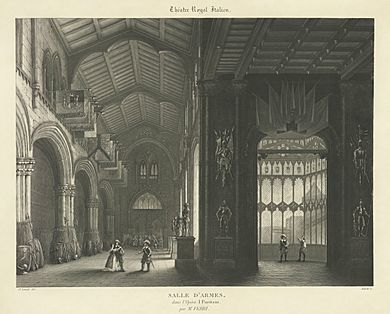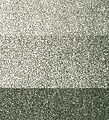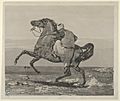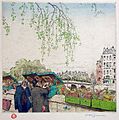Aquatint facts for kids

Aquatint is a special way to make prints, like drawing with ink on paper. It's a type of intaglio printmaking, which means the image is carved into a metal plate. Unlike regular etching that makes lines, aquatint creates areas of color or shade. Artists often use it with etching to add outlines to their pictures.
Aquatint was also used to make colorful prints. Sometimes, they used different plates for different colors. Other times, they printed in black and white and then added colors by hand with watercolour.
Contents
What is Aquatint?
Aquatint is a printmaking method that creates smooth tones, like a wash of paint. It's different from etching, which makes sharp lines. Imagine drawing with a pencil versus painting with a brush; aquatint is more like the brush.
How Aquatint Works
To make an aquatint print, artists use a metal plate, usually copper or zinc.
- First, they sprinkle tiny bits of resin powder onto the plate.
- Then, they heat the plate. This makes the resin melt and stick to the plate.
- Next, the plate is put into an acid bath. The acid bites into the metal only in the tiny spaces between the resin particles.
- The longer the plate stays in the acid, the deeper the pits become. Deeper pits hold more ink, making darker tones.
- Artists can cover parts of the plate with a protective varnish to stop the acid from biting there. This creates lighter areas.
- After the acid bath, the resin is removed. The plate is then inked and printed onto paper.
Why Artists Use Aquatint
Aquatint is great for creating prints with a wide range of tones, from very light to very dark. This allows artists to show different shades and textures in their work. It's often combined with etching to add fine lines and details.
History of Aquatint Prints
Aquatint became popular in the late 1700s. It was widely used between about 1770 and 1830. Artists used it for both fine art and decorative pictures.
When Aquatint Was Popular
After 1830, other printing methods like lithography became more common. However, artists still use aquatint today. It has seen several comebacks over the years.
Challenges with Aquatint Plates
An aquatint plate can wear out fairly quickly. It's also harder to fix or change than other types of printing plates. For example, some of Goya's famous plates were printed too many times after his death, which made the later prints look much less clear.
Famous Aquatint Artists
Many famous artists have used the aquatint technique to create their masterpieces.
- Goya is one of the most well-known artists who used aquatint. He created several major series of prints with this method.
- John James Audubon used aquatint for many of his detailed bird illustrations in The Birds of America. The colors were often added by hand.
- Mary Cassatt also created beautiful color prints using aquatint, often by printing with several different plates.
Images for kids
-
Goya, No. 32 of Los Caprichos (1799, Por que fue sensible). This is a fairly rare example of a print entirely in aquatint.
-
Joseph Lycett, The residence of Edward Riley Esquire, Wooloomooloo, Near Sydney N. S. W., 1825, hand-coloured aquatint and etching printed in dark blue ink.
-
Mary Cassatt, Woman Bathing, drypoint and aquatint, from three plates, 1890–91
-
Paul Sandby, The Iron Forge between Dolgelli and Barmouth in Merioneth Shire, Plate 6 of XII Views in North Wales, 1776, etching and aquatint printed in brown.
-
Paul Sandby, View near Edwinsford, Carnarvonshire, 1812, with colours added by hand.
-
Goya, # 20 from the Tauromaquia series (1816), The agility and audacity of Juanito Apiñani in the ring at Madrid, etching and aquatint
-
Eugène Delacroix, Turk Mounting His Horse, 1824, aquatint only.
-
Edgar Degas, Dancers in the Wings (Danseuses dans la coulisse), c. 1877, etching, aquatint, and drypoint
-
Félicien Rops, Little Sorceress, 1879, etching and aquatint
-
Comedy of Society, Jacques Villon
-
Allan Osterlind, Flamenco Dancers
See also
 In Spanish: Grabado al aguatinta para niños
In Spanish: Grabado al aguatinta para niños




















